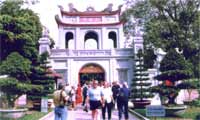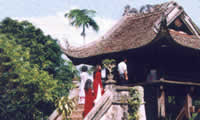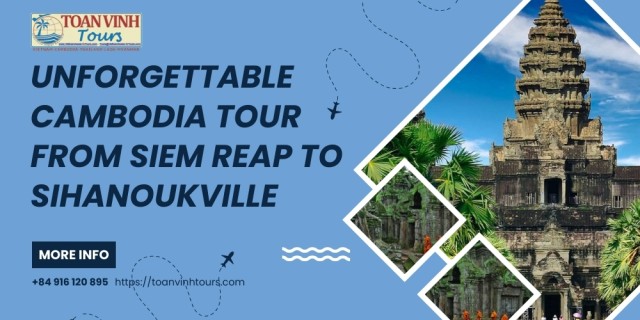 Buit on the former site of the ancient city of Dai La, on the right bank of the Hong River (Red River), Hanoi, the historical and political capital of Vietnam, was the name Emperor Minh Mang gave to the ancient capital of Thang Long founded in 1010 by King Ly Thai To. According to legend, on his arrival in Dai La, King Ly Thai To saw an enormous golden dragon emerge from the lake and soar into the sky above the site of the future capital. On the strength of this he decided to move the capital from Hoa Lu to Dai La which he renamed Thang Long (Ascending Dragon) Hanoi has been inhabited since the Neolithic age. The city is bordered by high hills and mountains in the northwest, with 7 urban districts and 5 suburban districts.
Buit on the former site of the ancient city of Dai La, on the right bank of the Hong River (Red River), Hanoi, the historical and political capital of Vietnam, was the name Emperor Minh Mang gave to the ancient capital of Thang Long founded in 1010 by King Ly Thai To. According to legend, on his arrival in Dai La, King Ly Thai To saw an enormous golden dragon emerge from the lake and soar into the sky above the site of the future capital. On the strength of this he decided to move the capital from Hoa Lu to Dai La which he renamed Thang Long (Ascending Dragon) Hanoi has been inhabited since the Neolithic age. The city is bordered by high hills and mountains in the northwest, with 7 urban districts and 5 suburban districts.
Today, visitors to Hanoi will encounter the cultures of both east and west. The changing fortunes of history are reflected in the architecture of it many traditional temples and pagodas, the ruin of ancient citadel and the lingering presence of the French remnants of its colonial past. Hanoi still preserves its old charms with the old quarter of 36 streets and guilds, beautifully situated among numerous.
Temple of Literature
 The Temple of Literature was built in 1070 as a dedication to the founder of Confucianism. Six years later, the school of Quoc Tu Giam was built in the premises of the Temple of Literature and considered as the first university of Vietnam, open not only to princes and children of the royal family members, but also to talented students around the country. The whole structure is about 350m long and 70 m wide and surrounded by a vast wall of bricks. There are five courtyards inside, and in an open courtyard, under the trees on either side, stand 82 stone steles. The steles are carved with the names, works and academic records of the doctors of philosophy who passed the King's examinations from 1498 to 1787. Each stele is placed on the back of a marble turtle representing the nation's longevity.
The Temple of Literature was built in 1070 as a dedication to the founder of Confucianism. Six years later, the school of Quoc Tu Giam was built in the premises of the Temple of Literature and considered as the first university of Vietnam, open not only to princes and children of the royal family members, but also to talented students around the country. The whole structure is about 350m long and 70 m wide and surrounded by a vast wall of bricks. There are five courtyards inside, and in an open courtyard, under the trees on either side, stand 82 stone steles. The steles are carved with the names, works and academic records of the doctors of philosophy who passed the King's examinations from 1498 to 1787. Each stele is placed on the back of a marble turtle representing the nation's longevity.
One Pillar Pagoda
 Built in 1049 under the Ly dynasty, to the west of the city, this square wooden pagoda rests on one pillar in the middle of a green lotus pond. Legends said that King Ly Thai To was old but had no son. One night, in a dream the king saw the goddess of Mercy sitting on a lotus flower offering him a male child. Shortly after that the queen got pregnant and she gave birth to a son. The king thanked the goddess by ordering the construction of this pagoda in the form of a lotus and named it Dien Huu, meaning long lasting happiness and good luck.
Built in 1049 under the Ly dynasty, to the west of the city, this square wooden pagoda rests on one pillar in the middle of a green lotus pond. Legends said that King Ly Thai To was old but had no son. One night, in a dream the king saw the goddess of Mercy sitting on a lotus flower offering him a male child. Shortly after that the queen got pregnant and she gave birth to a son. The king thanked the goddess by ordering the construction of this pagoda in the form of a lotus and named it Dien Huu, meaning long lasting happiness and good luck.
The Old Hanoi Quarter
Hanoi old quarter consists of 36 streets and guilds, each for selling a different kind of commodities. Many streets begin with the word "Hang" (street), following it is a word indicating the trades and commodities; for example, Hang Gao (street of rice) selling rice, Hang Duong (street of sugar) selling sugar, sweeties and cookies, and so on. This old quarter still preserves the Hanoi images that inspire the unique sensation of the past of Hanoi. The soul of the old Thang Long City rests in the ancient town center that we can feel when visiting Hanoi of 36 streets and guilds.
Co Loa Citadel
This is perhaps the most ancient citadel in Vietnam, built by King An Duong Vuong between 214 and 208 BC to make it the capital of the Au Lac State (the name of Vietnam at that time). The citadel has the structure of an oyster shell with 3 turns: the exterior, the middle and the interior.
Your browser does not support inline frames or is currently configured not to display inline frames. Legends said that one night the white cocks badly damaged the citadel. The god of river knew the damage and mysteriously interfered by sending a holy tortoise to protect the citadel building. When the construction was completed, a magic bow was given to king An Duong Vuong to defeat the northern invaders from China. The Chinese King Trieu Da knew the story and planned to have his son, Prince Trong Thuy, marry Princess My Chau the daughter of King An Duong. Trong Thuy made use of the opportunity and stole this magic weapon. War happened shortly after that, the Vietnamese king lost. He, together with his daughter committed suicide. Commemorating the king and the princess with their good deeds, his people constructed a temple to worship them which still remains intact up to now. Visitors will also find the remains of the citadel and many vestiges here.
West Lake
Your browser does not support inline frames or is currently configured not to display inline frames. West Lake is the biggest lake in central Hanoi, covering 500 ha in Tay Ho district. It is one of the main attractions of Hanoi City. In the ancient times, this place used to be a famous resort reserved for kings and mandarins. Many beautiful palaces and monuments were built on the bank of the lake, among them are Thuy Hoa Palace, Tu Hoa Palace, Ham Nguyen Sanctuary, Kim Lien pagoda and Ngoc Dam Palace. The 14-km path around the lake leads to different places of interest such as Nghi Tam and Tay Ho flower villages, the peach gardens of Nhat Tan and the famous Tay Ho Temple.
Situated on an island in the West Lake is the Tran Quoc pagoda, the oldest pagoda of Vietnam built in 541. Its ancient towers mirror in the lake water. Inside the pagoda there is a very precious statue, that of Buddha Sakyamuni entering Nirvana, a masterpiece of Vietnamese sculptural art.
Huong Pagoda
 The Huong Pagoda (Perfume Pagoda) is a complex of pagodas set amidst mountains, forests, lakes and caves, surrounded by vast green rice-growing plains, about 75 km from Southwest of Hanoi. A boat ride on the Yen Vi Stream through the green paddies to the mountain where the pagodas is located is interesting. The main pagoda is situated on the top of a mountain. Many people believe that this is a place where the deities purify souls, cure sufferings, and grant offspring to childless families. Going to the Huong Pagoda must be a good chance of boating, hiking and relaxation.
The Huong Pagoda (Perfume Pagoda) is a complex of pagodas set amidst mountains, forests, lakes and caves, surrounded by vast green rice-growing plains, about 75 km from Southwest of Hanoi. A boat ride on the Yen Vi Stream through the green paddies to the mountain where the pagodas is located is interesting. The main pagoda is situated on the top of a mountain. Many people believe that this is a place where the deities purify souls, cure sufferings, and grant offspring to childless families. Going to the Huong Pagoda must be a good chance of boating, hiking and relaxation.
Especially, every year the Huong Pagoda Festival taking place in spring attracts tens of thousands of tourists and pilgrims coming to implore the spirits for good luck, wealth, and happiness, and also to admire the beautiful landscapes of the area. The festival takes place for two months from 15th of the first lunar month to the 15th of the 3rd lunar month.
 Hung Temple Vestiges
Hung Temple Vestiges
Den Hung Vestiges are located approximately 95 km from Hanoi. This group of vestiges is tied to the legend of the 18 Hung Kings who built Van Lang State (Vietnam in the past). Among the vestiges are the tomb of a Hung King and the Gieng (well) Temple located at the foot of the mountain. In the temple there is a well where the two daughters of the 18th Hung King had the habit of looking at their reflection in the well to comb their hair. On Nghia Linh Mountain, many artifacts and vestiges of the Van Lang civilization such as Stone axes, bronze spears, ceramic bowls and plates, stone columns, terra cotta jars, bricks and tiles still remain.







Login to Leave a Comment